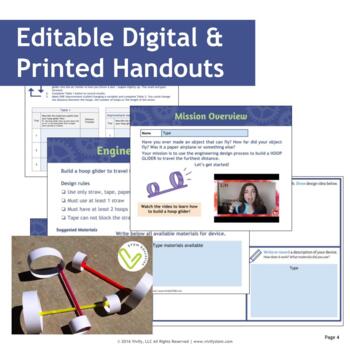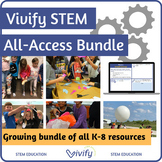STEM Activity Hoop Glider Challenge (Variable Testing)
- PDF
What educators are saying
Also included in
- Are you in need of year-round STEM activities? This growing bundle includes our most popular STEM lessons and engineering design challenges for elementary! Activities are adaptable for 1st through 5th grade with guidance provided in the teacher notes. Need help with a STEM Curriculum Map? Grab our FPrice $410.72Original Price $513.40Save $102.68
- Are you in need of year-round STEM activities? This growing bundle includes ALL Vivify K-12 STEM lessons from team challenges, engineering design, semester-long STEM units, research projects, and more! Purchase everything for 20% off individual products! Here is a sample of what is included: Stage 1Price $990.24Original Price $1237.80Save $247.56
Description
Hoop Glider STEM Activity with Digital & Printed Journal and Teacher Slides!
The hoop glider STEM activity includes building a glider made from straw, tape, and index cards or paper to travel the farthest distance. Different activity versions are provided to accommodate student ability and time constraints.
Topics Covered:
- Scientific Method through Variable Testing
- STEM Career: Aerospace Engineering
- Engineering Design Process
- Forces of Flight
- Ratios
This hands-on activity shows students how to optimize an engineering design through systematically testing variables. Students will learn how to build a standard hoop glider out of straws and paper, conduct testing, and then change different variables to determine the effect on flying distance.
Lower Elementary: Younger students use the engineering design process student handouts to design a hoop glider to travel the farthest distance. This activity is teacher-led and uses trial and error in testing.
Upper Elementary: Students use the engineering design process to build and test a hoop glider. Teachers can extend the learning by testing one or two variables as a class or as partners.
Middle School: Students use the full activity guide to test 5 variables in building a hoop glider compared to the standard glider. Students will try different numbers of hoops, lengths of straws, the distance between hoops, and hoop diameters (including ratios between hoops).
Included in this product:
- Teachers guide with links to resources
- Editable Teacher Slides
- Editable Student handouts
- Science behind hoop gliders
- Student design sheets including "compact version" with engineering design handouts or "expanded version" for testing 5 different hoop glider variables
- Engineering design posters
- STEM Career Connection: Aerospace Engineering
- Reflection questions
Looking for more STEM lessons? Our team of engineers and educators is dedicated to developing low-prep and high-quality STEM activities for any classroom! Click below to learn more:
- Vivify's Scope & Sequence + Standards Alignment
- Vivify's Resource Guide
- Learn about the 3 Stages of STEM
- Vivify STEM Membership
Customer Tips:
• Click the Green ★ to follow our store and get notifications of new products and freebies
• Leave feedback to receive TpT credit for use on future purchases
• Questions? Contact us in the Product Q&A section
♥ Connect With Us ♥
Email us: info@vivifystem.com







